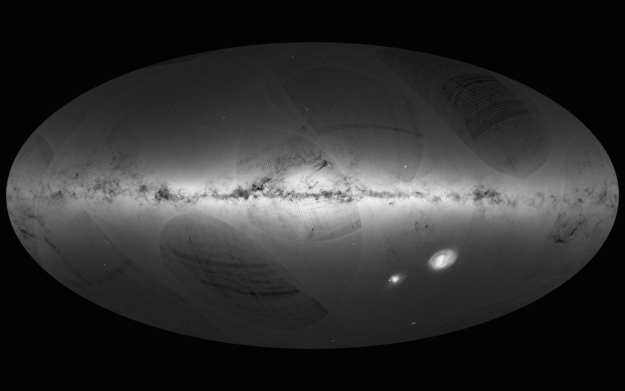Astronomers the world over are about to get their first taste of a tool that will transform their working lives.
Gaia, a space telescope launched by the European Space Agency (ESA) in late 2013, will release its first map of the Milky Way on 14 September. The catalogue will show the 3D positions of 2,057,050 stars and other objects, and how those positions have changed over the past two decades. Eventually, the map will contain one billion objects or more and will be 1,000 times more extensive and at least 10 times more precise than anything that came before.
The release next week will also include 19 papers by Gaia astronomers who have already seen the data. But independent teams are getting ready for their first glimpse. Lennart Lindegren, an astronomer at the Lund Observatory in Sweden and a major driving force in the Gaia project since it was first proposed in 1993, expects astronomers to produce 100 or so papers just in the weeks following the draft catalogue release.
Some groups have planned ‘Gaia hacking’ and ‘Gaia sprint’ events, at which researchers will collectively work out how best to exploit the sudden manna. “Gaia is going to revolutionize what we know about stars and the Galaxy,” says David Hogg, an astronomer at New York University who is leading some of these efforts. So what are some of the revelations that Gaia could make?
Milky Way archaeology

NASA/JPL
The structure of the Milky Way (artist's impression) may soon be better understood.
Gaia’s 3D view of Milky Way in motion will reveal how stars move under its combined gravitational pull. This will add to knowledge of the Galaxy’s structure, including parts that are not directly visible from Earth, such as the ‘bar’ — two arms that stick straight out of the Galactic Centre and join it to the spiral arms.
Researchers will be able to identify ‘outlier’ groups of stars which stream together at high speeds, and which are thought to be remnants of mergers with smaller galaxies, says Michael Perryman, an astronomer at University College Dublin and a former senior scientist for Gaia at ESA. Combined with existing information about factors including stars’ colour, temperature and chemical composition, this detailed map will enable researchers to reconstruct the Galaxy’s archaeology: how it got to its present state over the past 13 billion years. “Over its lifetime, Gaia is going to radically impact our understanding of the structure of the Milky Way and its evolutionary history,” says Monica Valluri, an astronomer at the University of Michigan in Ann Arbor.
Where is the Milky Way's dark matter?
The details of star trajectories inside the Galaxy will reveal the distribution not only of visible matter, but also of dark matter, which constitutes the bulk of most galaxies’ mass. And that in turn could help to reveal what dark matter is.
Gaia might also put some exotic theories to the test. Standard dark-matter theory predicts that the gravitational field of the Galaxy is spherically symmetrical near the Galactic Centre but then becomes elongated “like an American football” farther out, Valluri explains. But an alternative theory called MOND (modified Newtonian dynamics) implies that the field is shaped more like a pancake. By looking at the velocities of stars, which depend on the gravitational field, Gaia will be able to test which theory is right.
The probe’s data might even reveal evidence for the idea that dark matter killed the dinosaurs. If dark matter is concentrated in a relatively thin ‘dark disk’ near the Galactic plane, says the audacious theory, it could trigger asteroid impacts that cause mass extinctions when the Solar System periodically crosses the disk.
Disputed stellar distances

NASA, ESA and AURA/Caltech
How far is the Pleiades star cluster from the Sun?
Precise measurements of how far individual stars lie from the Sun will enable astrophysicists to fine-tune their models of how stars evolve. That is because current theories rely heavily on estimates of distance to understand how a star’s intrinsic brightness changes during its lifetime.
One of the first groups of stars that researchers will want to check is the Pleiades, a cluster in the constellation Taurus. Most observations, including one1 made with the Hubble Space Telescope, put the cluster about 135 parsecs (440 light years) away. But results based on data from Hipparcos, an ESA space mission that preceded Gaia, suggest 2 that it is only 120 parsecs away.
Some have said that the discrepancy casts doubt on the accuracy of Hipparcos. Gaia uses a similar, but much more evolved, method to Hipparcos, so astronomers will be watching its observations closely. “I believe that the Hipparcos result will very likely be proved wrong by Gaia,” says David Soderblom of the Space Telescope Science Institute in Baltimore, Maryland, who is an author on the Hubble study.
Thousands of new worlds
Astronomers have discovered thousands of planets orbiting other stars, in most cases by detecting tiny dips in a star’s brightness when an orbiting planet passes in front of, or ‘transits’, it. Gaia will detect planets using another method: measuring slight wobbles in the star’s position caused by a planet’s gravitational pull.
“It seems like a good bet that the mission will reveal thousands of new worlds,” says Gregory Laughlin, an astronomer at Yale University in New Haven, Connecticut.
Gaia’s technique is best suited to detecting large planets in relatively wide orbits, says Alessandro Sozzetti, a Gaia researcher at the Astrophysical Observatory of Turin in Italy. And unlike the transit method, it directly measures a planet’s mass. If it works, it will be a striking comeback for a technique that has seen many false starts.
But finding planets in this way will require several years of observation, with a sneak preview expected by 2018, Sozzetti says.
How fast the Universe is expanding

NASA
Variable star RS Pup, located in the Milky Way, is used as a standard candle.
Although Gaia is primarily an explorer of the Milky Way, its influence will reach across the entire observable Universe.
Gaia’s direct distance measurements work only for objects in the Galaxy or its immediate vicinity; to estimate the distances to faraway galaxies, astronomers typically wait for stellar explosions called Type Ia supernovae. The apparent brightness of such a supernova reveals how far away the corresponding galaxy is. Such signposts, or ‘standard candles’, have been the main tool for estimating the rate of expansion of the Universe. The measurements have led astronomers to propose that a mysterious ‘dark energy’ has been accelerating that expansion.
But to use supernovae as signposts, astronomers must compare them with other types of standard candle in our Galaxy. In its first release, Gaia will measure the distances of thousands of such stars to high accuracy. Eventually, the probe’s measurements will enable cosmologists to improve their maps of the entire Universe and perhaps to resolve some conflicting estimates of its rate of expansion.
Invisible asteroid threats
As it constantly scans the sky, Gaia will also track and discover things much closer to home. It is ultimately expected to find some 350,000 asteroids inside the Solar System, says Gaia astronomer Paolo Tanga of the Côte d’Azur Observatory in Nice, France. These will include near-Earth objects (NEOs), those whose orbits bring them within about 200 million kilometres of Earth.
When it spots an NEO, Gaia can alert observatories, which can then use ground-based telescopes to establish whether the object is a threat. From its vantage point in space, Gaia will scan nearly the entire sky and so might reveal objects that, during certain times, are too close to the Sun to be observed from Earth, says Anthony Brown, an astronomer at the Leiden Observatory in the Netherlands who chairs Gaia’s data-processing collaboration. “We can observe in areas you cannot normally reach from the ground at the same time.”
By tracking the way certain asteroids orbit the Sun over several years, Gaia will also be able to perform sensitive tests of Albert Einstein's description of gravity, his general theory of relativity.
Quelle: nature
-
Update: 14.09.2016
.
GAIA’S BILLION-STAR MAP HINTS AT TREASURES TO COME
The first catalogue of more than a billion stars from ESA’s Gaia satellite was published today – the largest all-sky survey of celestial objects to date.
On its way to assembling the most detailed 3D map ever made of our Milky Way galaxy, Gaia has pinned down the precise position on the sky and the brightness of 1142 million stars.
As a taster of the richer catalogue to come in the near future, today’s release also features the distances and the motions across the sky for more than two million stars.
“Gaia is at the forefront of astrometry, charting the sky at precisions that have never been achieved before,” says Alvaro Giménez, ESA’s Director of Science.
“Today’s release gives us a first impression of the extraordinary data that await us and that will revolutionise our understanding of how stars are distributed and move across our Galaxy.”
Launched 1000 days ago, Gaia started its scientific work in July 2014. This first release is based on data collected during its first 14 months of scanning the sky, up to September 2015.
“The beautiful map we are publishing today shows the density of stars measured by Gaia across the entire sky, and confirms that it collected superb data during its first year of operations,” says Timo Prusti, Gaia project scientist at ESA.
Quelle: ESA
-
Update: 24.09.2016
.
Gaia clocks speedy cosmic expansion
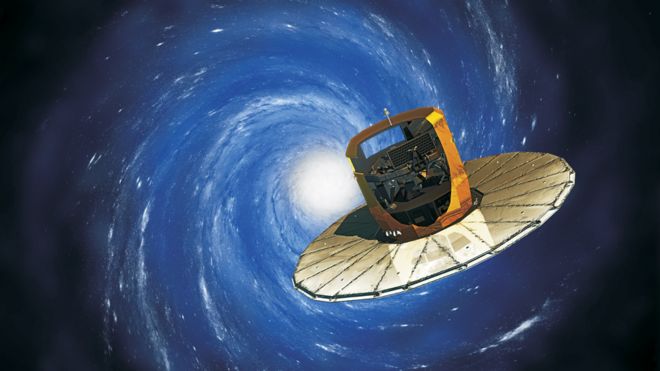 Image copyrightESA
Image copyrightESA
Europe’s Gaia space telescope has been used to clock the expansion rate of the Universe and - once again - it has produced some head-scratching.
The reason? The speed is faster than what one would expect from measurements of the cosmos shortly after the Big Bang.
Some other telescopes have found this same problem, too.
But Gaia’s contribution is particularly significant because the precision of its observations is unprecedented.
“It certainly ups the ante,” says Adam Riess from the Space Telescope Science Institute (STScI) and the Johns Hopkins University, both in Baltimore, Maryland, US.
The inability to lock down a value for the expansion rate has far-reaching consequences - not least in how we gauge the cosmic timescale.
If the Gaia speedometer is correct, it would mean having to reduce the estimated 13.88-billion-year age of the Universe by perhaps a few hundred million years.
Cosmic 'ladder'
The European Space Agency (Esa) mission, launched in 2013, is making the definitive map of our Milky Way Galaxy, logging extremely accurate distances to a billion nearby stars.
Just last week, it issued the first tranche of separations to two million objects, and this information was immediately seized upon by thousands of astronomers worldwide - Prof Riess and his team among them.
The Nobel Laureate was interested in a specific subset of stars in the data dump known as cepheid variables.
These are pulsating stars that puff up and deflate in a very regular fashion and shine with a known power output.
They are a lower rung on the “ladder” that astronomers use to plot the separation between our galaxy and the positions of galaxies that lie billions of light-years away.
Once you know the cepheids’ exact distance, you can use their behaviour to calibrate higher rungs on the ladder - specifically, a class of supernovae, or exploded stars, that also shine in a standard way.
And by probing a sufficiently deep volume of space, it is then possible to trace the rate at which the modern cosmos is expanding.
Gaia's imperative - To work out how far it is to the nearest stars
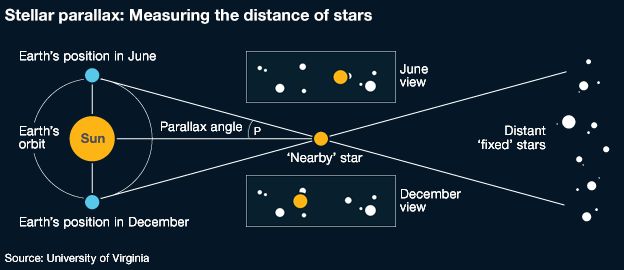
- As the Earth goes around the Sun, relatively nearby stars appear to move against the "fixed" stars that are even further away
- Because we know the Sun-Earth distance, we can use the parallax angle to work out the distance to the target star
- But such angles are very small - less than one arcsecond for the nearest stars, or 0.05% of the full Moon's diameter
- Gaia will make repeat observations to reduce measurement errors down to seven micro-arcseconds for the very brightest stars
- Parallaxes are used to anchor other, more indirect techniques on the 'ladder' deployed to measure the most far-flung distances
The tell-tale is the way the light from progressively more distant galaxies becomes stretched to longer wavelengths.
This relationship is known as the Hubble Constant and tying down its value is one of the great quests in astronomy.
Working with a clutch of 212 Gaia cepheids, Prof Riess’s team gets a Hubble Constant for today’s Universe of 73.0 kilometres per second per megaparsec (a megaparsec is 3.26 million light-years).
Or put another way - the expansion increases by 73.0km/second for every 3.26 million light-years we look further out into space.
The number is almost exactly the same as the value the Riess group has produced using cepheids observed by the mighty Hubble telescope (73.2km/s per megaparsec). Both values have an uncertainty of just over 2%.
The problem is that these calculations come out quite a bit bigger than the one that has been determined using a very different method.
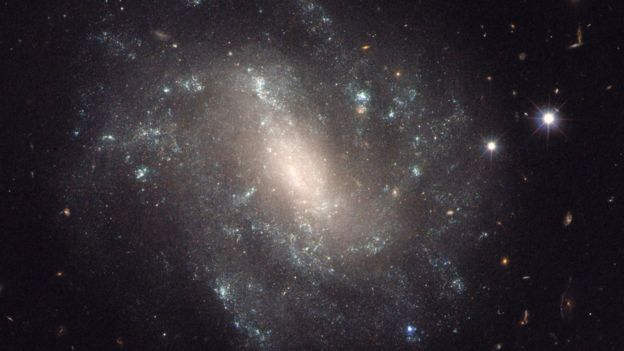 Image copyrightNASA/ESA
Image copyrightNASA/ESA
This alternative focuses on the Universe as it was just after the Big Bang and relies on what we know about the contents and the physics at work in the cosmos to predict a modern value of the expansion.
It has been done most recently using data from Esa’s Planck space telescope, which produced the most detailed description of the “oldest light” in the sky - a remnant glow of microwave radiation from the Big Bang itself.
Going with this method gives a Hubble Constant of 66.9km/s per megaparsec.
As Gaia repeats and extends its cepheid measurements in the years ahead (and it is expected to plot precise distances to at least 7,000), the confidence in its Hubble Constant calculation is likely only to increase.
This would put pressure on scientists to revise some of the components they plug into the Planck side to remove the tension that exists between the two approaches. And it is a fair bet that any such revisions are almost certainly rooted in what we know - or rather do not know - about the “dark Universe”.
These include the unseen matter in galaxies (dark matter), the vacuum energy (dark energy) postulated to be driving an acceleration in cosmic expansion, and even hitherto unidentified massive particles.
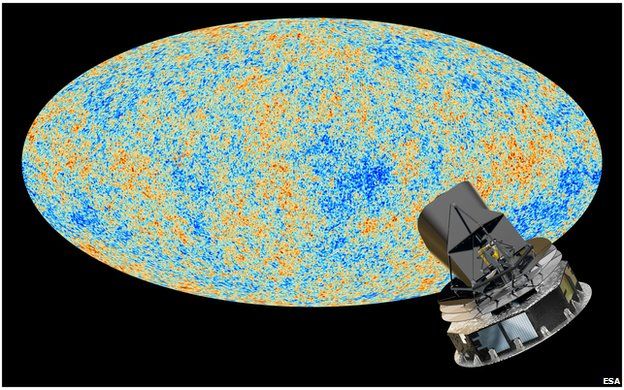 Image copyrightESA
Image copyrightESA
“Gaia is going to be a very important, really revolutionary, way to measure distances,” said Prof Riess.
“Ultimately, when Gaia is done, we ought to be able to measure the Hubble Constant to 1% precision. That’s the same precision that is predicted by the Cosmic Microwave Background. That will be really powerful.
"And if there is a discrepancy, if there's something interesting going on in the dark sector of Universe, it should give us much better evidence of what that is,” he told BBC News.
Prof Gerry Gilmore was a proposer of the Gaia mission and is one of its senior researchers.
He said members of the Gaia science team had also run the cepheid numbers and produced a value very similar to Prof Riess’s.
Asked to list possible reasons for the discrepancy, the Cambridge University scientist raised the possibility that dark energy was time-dependent - that its influence evolves through the history of the Universe.
“Another idea that people have become quite keen on in the past year is that we actually live, by chance, in a low-density part of the Universe,” he explained.
“It’s still quite a big part of the cosmos, perhaps 1-2%, but because it’s a low-density part it’s accelerating faster than the average.”
Quelle: BBC



